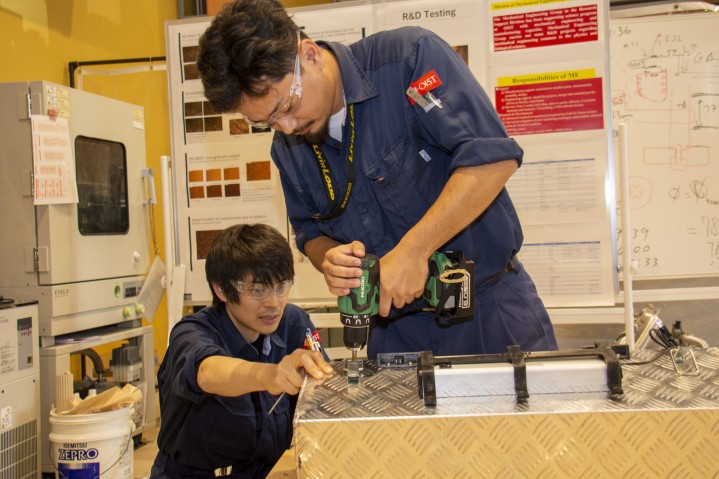Prof. Keshav Dani and his team have developed a UVC sterilization unit that could allow hospitals to safely reuse masks when necessary.
Updated May 2, 2020
One UVC sterilization unit has now been set up at Nanbu Hospital. The staff at Tomishiro Chuou Hospital continue to use their units to support the mask shortage and have found them to be reliable.
Updated April 27, 2020
Two UVC sterilization units are now at Tomishiro Chuou Hospital and one unit is at Naha City Hospital. These units were designed and built at OIST. The aim was to make them easy and safe for hospital staff to use.
The staff at Tomishiro Chuou Hospital are using both units in their coronavirus ward and have reported that they are finding them very useful.
April 17, 2020
A team from OIST, led by Professor Keshav Dani from the Femtosecond Spectroscopy Unit has designed and built an apparatus that sterilizes Personal Protective Equipment (PPE), such as N95 masks, using short-wavelength ultraviolet (UVC) light. The apparatus also compares the post-sterilization performance of the masks to their original specifications. Each unit can disinfect around 400 N95 masks a day, with the hope that a limited supply of masks could be extended.
The first step involved a collaboration between Hemanta Sarmah and Nao Ohmine-san of the Cell Signal Unit, Ankur Dhar of the Quantum Wave Microscopy Unit, and Vivek Pareek, Abdullah Al Mahboob, and Viktoras Lisicovas of the Femtosecond Spectroscopy Unit. Through a direct measurement, they established the dose of UVC needed to effectively sterilize the N95 masks and found that it was 100 to 1000 times higher for an N95 mask than previously reported on other surfaces.
The team also developed a test to check the filtration efficiency of the N95 masks after sterilization. They used a CPR dummy with sensors at the back of its throat. These sensors counted how many sub-300 nm particles came through when the dummy simulated a breath of air. This test was performed both with and without an N95 mask on the dummy, to determine the filtration efficiency of the mask. N95 masks should ideally be able to filter 95% of particles under 300nm. The team confirmed that multiple rounds of UVC sterilization at the right dose left the filtration capability of the mask unchanged.
“We found that even after 30 rounds of sterilization, these masks performed well. To us, the limiting factor seems to be general wear and tear, rather than the sterilization process,” said Professor Dani. “We are working now with one of the local hospitals to do daily filtration-efficiency tests of the masks after they are used by medical professionals and after exposure to the required UVC sterilization dose. This study will provide a very solid data point on how often one can safely re-use N95 masks.”
To be able to sterilize the masks in the hospitals itself and to conduct the filtration efficiency tests, the group has had to develop easy-to-use, safe and compact apparatus that can be operated by hospital staff. With these constraints in mind, and much-needed help from the Engineering Support Section and Buildings and Facilities Management Division, the team has designed, built and tested multiple sterilization units. The first few units have been delivered to hospitals in Naha and additional units are under construction.






